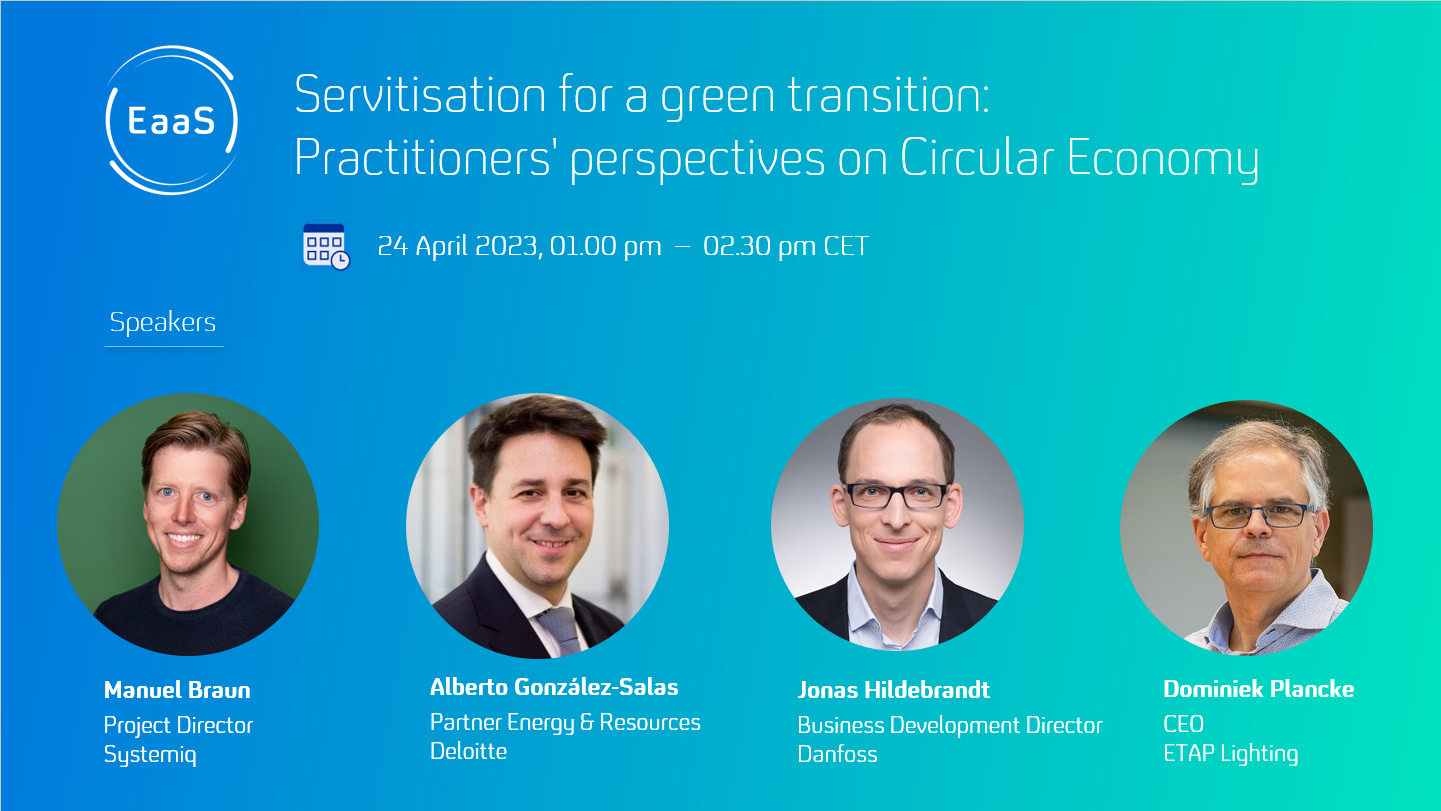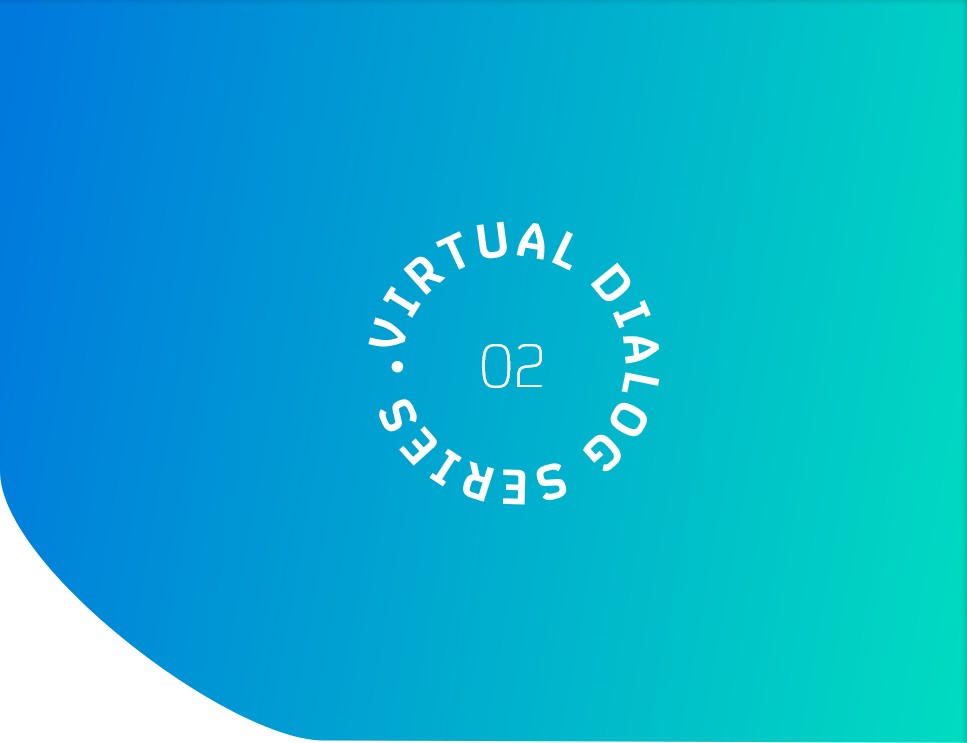Key Takeaways – Servitisation for a green transition: Practitioners’ perspective on CE
Second EaaS Consortiums' International Virtual Diaolog
Servitisation for a green transition - practitioners' perspective on circular econonomy
XaaS - How Businesses Can Thrive In The Age Of Climate Change And Digitalization
- Linear operating systems have systemic inefficiencies in terms of resource use and emissions that optimisation alone cannot fully address. The aim of the circular economy is to decouple the use resources from resource extraction leading to a much more productive way of operating the industry system.
- Embedding circular economy principles requires a complexity of measures on the supply side and on the demand side and changes in the business models applied.
- Servitisation is a radical business model innovation model that relies on selling services or outcomes instead of a product.
- When designed right, servitisation has a lot of power to combine ecological benefit with an economic benefit. As the producers gets back the equipment at the end of first use or end of life, he is incentivized to optimize all stages of the product value chain, designing the product for longevity and reparability.
- XaaS models being quite revolutionary their development, they require strong leadership coupled with a strategic and long term perspective.
- As the global dynamics are getting increasingly challenging, with pressure on supply chains, resilience and transparency has become a key priority for many companies. The need for flexibility is gaining in importance leading more and more companies to favour access over ownership.
EU Regulatory framework next 25 years
- The mainstream of investments in the EU for the upcoming years will revolve around energy and electrification of the economy. Many materials will be critical for that transformation. It is furthermore more estimated that 40 % of the EU decarbonization objectives are linked with resource efficiency aspects.
- As a consequence, the circular economy is a fundamental part of the EU Green transition regulatory streams: the EU Green Deal, Fit for 55, and Repower EU. The EU has set a target to improve its Resource efficiency by 30% by 2030 compared to 2014 levels.
- In addition to developing frameworks that will support a transition to a circular economy, future regulations are expected to penalize companies that do not adhere to circular economy principles.
- It is therefore expective that organisations not implementing circularity principles will face competitiveness challenges.
Servitization & Circularity – Refrigeration as a Service @ Danfoss
Danfoss is a multinational technology company headquartered in Denmark that is a leader in energy efficiency and is pioneering servitization propositions for supermarket customers.
Danfoss developed Refrigeration-as-a-Service (RaaS) model to cater the needs of supermarket customers that are not prepared or willing to deal with the technological changes and the expertise required to run the systems.
Learning and opportunities:
- For Danfoss, supplying RaaS means acting as a single point of contact and taking over the responsibility and risks associated with operating the refrigeration systems.
- The shift to RaaS has been an important one and required to build new capabilities and new capacities and partnering with project management and service operations company.
- RaaS being new for Danfoss, it brought its share of challenges that required everyone to embrace the changes affected the company: from its accounting to how it sells, operates and interacts with its customers. Danfoss strongest challenge in servitisation has been building the capabilities to develop an offer an RaaS solution.
- It has also been an important change for customers, requiring Danfoss to not only develop a strong proposition but also take the time needed to educate and communicate on this new value proposition.
- RaaS expands the scope of Stakeholder engagement at the customer as multiple departments are involved: technical, purchasing departments but also the CFO because these models have a strong financial Element to them.
- Building an ecosystem, identifying the smartest way to combine the various building block that form the value proposition is essential to unlock the highest value for the customer.
- As the provider takes care of operations, and knows its products best, servitisation is an enabler for integrating circular practices, such as product lifetime extension, reuse and remanufacturing.
- Servitisation can be bundled with green energy production to further improve its environmental footprint.
- Operating the equipment under RaaS enabled Danfoss to gain extremely valuable feedback and experience that would have otherwise not been possible to gain.
Circular economy and C-LaaS at ETAP
ETAP is a family owned company active in supplying lighting solutions in the working environment for 70 years. Circularity was embedded in the company purpose following a comprehensive analysis of trends and the need to address to mega-challenges: global climate change and the depletion of natural resources.
Learning and opportunities:
- Offering Lighting-as-a-service appeared as a necessity to accelerate the adoption of circular Lighting solutions. As it is only by keeping ownership of products that manufacturers can really stimulate a circular economy.
- LaaS cannot be done on one’s own and developing long-term partnerships has proved essential for ETAP to be able to offer such a solution to customers.
- Circularity is a journey. Steps have been taken but there is still a long way to go.
- The design stage is a critical step in the circularity journey. Looking at the building sector, 70% of its carbon footprint is linked to the usage phase. 80% of that impact is already being defined at the design stage. ETAP’s design focused on minimising the depreciation of the lumen output with time and maximizing the beam thereby reducing the need for luminaires.
- Where ETAP really challenges itself is in the renovation, questioning the need to replace the full luminaire when refurbishing is possible.
Recording and Q&As
The webinar can be viewed on the EaaS project Youtube Channel
The presentations are available here and the Q&A can be found here.
The speakers
- Manuel Braun, Project Director at Systemiq. Systemiq is a global think-and-do-tank focused on sustainability and the Circular Economy. Within Systemiq, Manuel is responsible for the circular business models work – partnering with pioneering organizations, investors and entrepreneurs. Before that, he spent 8 years at McKinsey where he led sustainable product development and design projects across industries.
- Alberto González-Salas, Partner Energy & Resources at Deloitte. Alberto has history of working in the management consulting industry and financial audit focusing amongst other on Energy Regulation, Business Transformation and energy business plan development.
- Jonas Hildebrandt, Business Development Director – Climate Solutions – Electronic Controllers & Services at Danfoss.Danfoss Climate Solutions delivers sustainable and energy efficient solutions for industry, the built environment and the entire food chain. Before joining Danfoss, Jonas spent almost 9 years at the Boston Consulting Group as a Project Leader.
- Dominiek Plancke, CEO at ETAP Lighting. ETAP stands for more than 70 years of energy-efficient, convenient and innovative lighting solutions in professional environments and strives for complete circularity. Dominiek Plancke has more than 30 years of experience in the lighting industry and is the CEO of ETAP Lighting International since November 2019.

